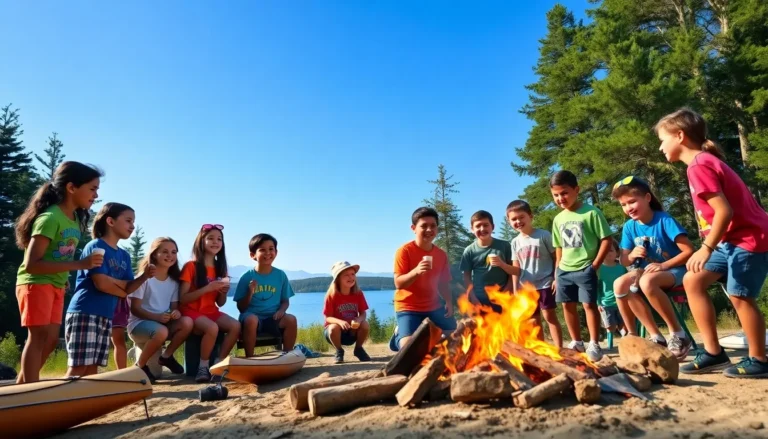Packing lunches for summer camp doesn’t have to feel like a daily battle with the lunch box. Parents across America face the same challenge: creating meals that’ll survive the heat stay fresh and actually get eaten instead of traded for someone else’s pudding cup.
From refreshing sandwich alternatives to creative snack combinations that’ll make other kids jealous summer camp lunches can be both nutritious and exciting. The key is finding the sweet spot between foods that’ll fuel active campers and treats that’ll bring smiles to their faces when they unzip their lunch bags. Whether it’s dealing with picky eaters or navigating food safety in the summer heat there’s a solution for every packed lunch predicament.
Table of Contents
ToggleWhy Summer Camp Lunches Need Special Planning
Summer camp lunches face unique challenges that require careful planning. Hot temperatures create food safety concerns as perishable items stay unrefrigerated for 4-6 hours. Active campers burn 400-600 more calories daily through swimming, hiking or sports activities compared to regular school days.
Camp environments present specific lunch considerations:
- Limited refrigeration access restricts food storage options
- Extended outdoor exposure subjects food to temperature fluctuations
- Physical activities increase nutritional demands
- Variable eating schedules affect meal timing
- Remote locations eliminate food replacement options
| Consideration | Impact | Solution |
|---|---|---|
| Temperature | Food spoilage risk |
Use insulated containers
| Activity Level | Higher calorie needs |
Pack protein-rich foods
| Time Span | 4-6 hours without refrigeration |
Include shelf-stable items
| Location | No access to backup food |
Pack extra snacks
Camp activities create distinct nutritional requirements:
- Higher protein demands from increased physical exertion
- Enhanced hydration needs due to outdoor activities
- Extra carbohydrates for sustained energy
- Increased portion sizes to match activity levels
- Strategic snack timing for energy maintenance
Parents must consider practical packing elements:
- Lightweight containers for easy transport
- Spill-proof packaging to prevent messes
- Single-serving portions to minimize waste
- Easy-open containers for younger campers
- Disposal methods for packaging materials
These factors make summer camp lunches different from regular school lunches, requiring specialized planning to ensure food stays fresh, safe and nutritious throughout active camp days.
Essential Summer Camp Lunch Guidelines
Summer camp lunch packing requires strategic planning to maintain food safety standards while providing nutritious meals. These guidelines ensure lunches stay fresh throughout the day regardless of outdoor temperatures.
Food Safety and Storage Tips
Food safety starts with temperature control in summer camp environments. An insulated lunch bag maintains cold foods at 40°F or below for up to 4 hours. Two frozen ice packs sandwich perishable items like meats cheese yogurt to prevent bacterial growth. Hot foods stay safe in thermal containers when heated to 165°F before packing.
| Temperature Guidelines | Time Limit |
|---|---|
| Cold Foods (≤40°F) | 4 hours |
| Hot Foods (≥140°F) | 4 hours |
| Danger Zone (40-140°F) | 2 hours max |
Packing Supplies You’ll Need
Quality packing supplies form the foundation of safe summer camp lunches. An insulated lunch bag serves as the primary container while compartmentalized bento boxes separate different food items. Reusable ice packs provide consistent cooling throughout the day.
- Insulated lunch bags with moisture-resistant linings
- Leak-proof containers in various sizes
- Gel-based ice packs (2-3 per lunch)
- Stainless steel thermal containers
- Silicone cupcake liners for small portions
- Reusable utensils marked with names
- Clean cloth napkins
- Small hand sanitizer bottles
No-Refrigeration Lunch Ideas
Packing lunches that stay fresh without refrigeration helps ensure campers enjoy safe meals in warm weather. These options remain stable at room temperature while providing essential nutrients for active kids.
Shelf-Stable Sandwiches and Wraps
Nut butter sandwiches create reliable lunch options that withstand warm temperatures throughout the morning. Sunflower seed butter paired with honey on whole grain bread offers a protein-rich alternative for nut-free camps. Tortilla roll-ups with shelf-stable fillings like cream cheese combined with dried fruit maintain their texture for 4+ hours. Adding vegetables like shredded carrots or cucumber slices introduces crunch without compromising food safety. Bagels spread with hummus provide another durable option packed with protein.
Protein-Rich Snack Combinations
Trail mix combinations incorporate lasting energy through mixed nuts, dried fruits dried fruits like raisins cranberries mango. Hard-boiled eggs in their shells stay fresh for 2 hours at room temperature when packed with cold packs. Individual packets of tuna or chicken salad paired with crackers deliver portable protein. Roasted chickpeas seasoned with salt pepper paprika offer crunchy protein-rich alternatives. Beef jerky combined with dried fruit creates lasting energy without refrigeration needs. Pre-portioned servings of nuts seeds pumpkin seeds sunflower seeds supply essential fats proteins minerals.
| Snack Combination | Protein (g) | Shelf Life |
|---|---|---|
| Trail Mix (1 cup) | 8-10g | 2-3 months |
| Hard-boiled Egg | 6-7g | 2 hours room temp |
| Tuna Pack | 15-17g | Until opened |
| Roasted Chickpeas (1 cup) | 14-15g | 1 week |
| Beef Jerky (1 oz) | 9-10g | 1-2 weeks |
Fresh and Cool Lunch Options
Summer camp lunches require refreshing options that stay appetizing in warm weather while providing essential nutrients for active campers. Here’s how to pack cool lunches that kids love to eat.
Creative Sandwich Alternatives
Pasta salads mixed with diced vegetables provide a filling alternative to traditional sandwiches. Mediterranean quinoa bowls with cucumber tomatoes remain fresh for 4 hours in insulated containers. Rice paper rolls filled with crisp vegetables carrots lettuce create light refreshing options. Cheese cubes paired with whole grain crackers offer protein-rich combinations that stay fresh with ice packs. Cold noodle dishes tossed with sesame dressing pack easily in leak-proof containers.
| Sandwich Alternative | Prep Time | Storage Time with Ice Pack |
|---|---|---|
| Pasta Salad | 15 min | 4-5 hours |
| Quinoa Bowl | 20 min | 4 hours |
| Rice Paper Rolls | 25 min | 3-4 hours |
| Cheese & Crackers | 5 min | 4-5 hours |
Refreshing Fruits and Vegetables
Frozen grapes watermelon chunks stay cold throughout morning activities providing natural refreshment. Cherry tomatoes cucumber slices maintain crispness in compartmentalized containers. Sugar snap peas baby carrots retain their crunch packed separately from wet ingredients. Citrus fruits like orange segments tangerines offer vitamin C essential for active campers. Berry medleys containing strawberries blueberries pack easily in small containers.
| Fruit/Vegetable | Benefits | Best Storage Method |
|---|---|---|
| Frozen Grapes | Natural ice pack | Insulated container |
| Watermelon | Hydration | Separate container |
| Cherry Tomatoes | Vitamin A & C | Ventilated container |
| Citrus Segments | Immune support | Sealed container |
| Berry Medley | Antioxidants | Small compartments |
Quick and Easy Make-Ahead Solutions
Make-ahead lunch solutions streamline summer camp meal preparation while maintaining food quality standards. Strategic planning creates nutritious options that stay fresh throughout camp activities.
Batch Cooking Tips
Batch cooking saves 3-4 hours weekly by preparing multiple lunch components simultaneously. Cook grains like quinoa rice in large portions using a 2:1 water-to-grain ratio for perfect texture. Roast vegetables at 400°F for 20 minutes to maintain crispness when packed. Portion cooked proteins such as chicken breast grilled turkey into 4-ounce servings. Store prepared components in airtight containers marked with preparation dates. Create assembly stations with labeled containers to expedite daily lunch packing. Rotate ingredients every 3 days to maintain freshness maximize variety.
Freezer-Friendly Options
Freezer meals retain optimal taste texture for up to 3 months when stored properly. Pack individual portions of pasta salads grain bowls in freezer-safe containers. Freeze sandwich fillings like tuna salad chicken salad separately from bread. Store smoothie ingredients in portion-sized bags for quick blending. Prepare portioned meatballs turkey slices wrapped individually. Flash freeze fresh fruit pieces on baking sheets before transferring to storage bags. Label containers with contents dates using permanent markers masking tape. Thaw frozen items overnight in the refrigerator for proper temperature control.
Conclusion
Packing the perfect summer camp lunch doesn’t have to be complicated. With proper planning safety measures and creative meal ideas parents can ensure their kids stay energized and satisfied throughout their action-packed camp days.
The right combination of nutritious foods packed in appropriate containers with proper temperature control will keep campers fueled for their activities. Whether opting for make-ahead meals shelf-stable options or fresh alternatives there’s a solution for every family’s needs.
By following food safety guidelines and incorporating a mix of proteins whole grains fruits and vegetables parents can create lunches that are both practical and enjoyable. These strategies will help make summer camp lunch preparation easier while keeping young campers healthy happy and ready for adventure.






